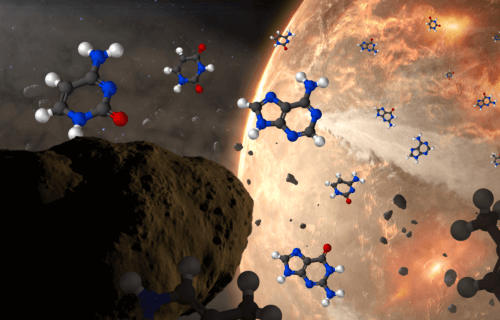GREENBELT, Md. — Did life on Earth start out in the cosmos? Scientists have discovered the final building blocks of life inside of asteroids, adding to the theory that meteorites may have seeded our planet with the necessary material to create unique lifeforms long ago.
Researchers from NASA’s Goddard Space Flight Center and Hokkaido University in Japan explain that DNA and RNA contain the genetic instructions which build every living thing on Earth. This genetic material contains five informational components, which scientists call nucleobases.
Until now, scientists have only been able to find three of these five components in rock samples coming from space. The new study, led by Associate Professor Yasuhiro Oba, has finally identified the last two nucleobases which combine to create life in the universe.
Specifically, nucleobases belong to classes of organic molecules called purines and pyrimidines. The team notes that it’s still a mystery why scientists haven’t found more of these molecules inside meteorites.
“I wonder why purines and pyrimidines are exceptional in that they do not show structural diversity in carbonaceous meteorites unlike other classes of organic compounds such as amino acids and hydrocarbons,” says Oba in a media release. “Since purines and pyrimidines can be synthesized in extraterrestrial environments, as has been demonstrated by our own study, one would expect to find a wide diversity of these organic molecules in meteorites.”
“We now have evidence that the complete set of nucleobases used in life today could have been available on Earth when life emerged,” adds co-author Danny Glavin from NASA’s Goddard Space Flight Center.
Life from ‘extraterrestrial broth’?
Study authors believe the final two nucleobases, cytosine and thymine, have been so hard to find because of their delicate structure. Previous experiments have created a “meteorite tea” by placing grains of meteorite dust into a hot bath. This let the molecules extract into the solution where scientists could then analyze the makeup of the “extraterrestrial broth.”
“We study these water extracts since they contain the good stuff, ancient organic molecules that could have been key building blocks for the origin of life on Earth,” Glavin says.
In the new study, the team used cool water to extract the life-creating compounds instead of hot formic acid — which is very reactive but could end up destroying the delicate molecules. Next, scientists used more sensitive equipment to pick up traces of the nucleobases in the broth.
“This group has managed a technique that is more like cold brew than hot tea and is able to pull out more delicate compounds,” explains Jason Dworkin, a co-author of the paper at NASA Goddard. “I was amazed that they had seen cytosine, which is very fragile.”
Does this mean all life comes from space?
Although researchers say this is not complete and total proof that the building blocks of life on Earth originate in space, it does provide a complete set of nucleobases which make up present-day life on our planet.
“This is adding more and more pieces; meteorites have been found to have sugars and bases now,” Dworkin concludes. “It’s exciting to see progress in the making of the fundamental molecules of biology from space.”
The team analyzed three famous meteorites during this project. The Murchison, Murray, and Tagish Lake meteorites fell in Australia, Oklahoma, and Canada, respectively.
The Murchison meteorite, discovered near the town in 1969, has long been known to harbor dozens of amino acids. The Murray meteorite landed on a farm in 1933. The Tagish Lake meteorite hit its frozen surface in 2000. The loud explosion caused tremors over a wide area.
The study is published in the journal Nature Communications.
South West News Service writer Mark Waghorn contributed to this report.

